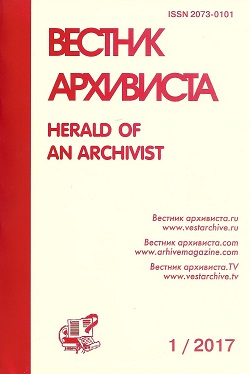Scientific article
УДК 94(47)+343.16+94(343.81)+94(343.82)
DOI 10.28995/2073-0101-2021-2-496-507
Denis N. Shkarevsky
Surgut State University, Surgut, Russian Federation
Personnel of the Penitentiary Courts in the USSR in 1944–56: Problems of Evolution
Abstract
The problem of existence of the camp (penitentiary) justice in the USSR remains practically unexplored. Neither has not been studied the development of its personnel. The article is to highlight the stages of the personnel potential formation of camp courts and to determine the significance of the elections of 1948–49 to the camp courts. The article is based on an analysis of previously unpublished documents stored in the State Archive of the Russian Federation and the Russian State Archives of Socio-Political History. The work is based on the use of historical, genetic, and systemic methods. For the first time, the dynamics of the development of personnel in the penitentiary justice has been revealed. There are two main stages. At the first stage, in 1944–48, the increase in formal indicators (legal education, age, work experience) was slow. The judges were selected and appointed by the People's Commissariat (Ministry) of Justice. The turning point was the election of judges of the penitentiary justice held in 1948–49. During the campaign, no more than 30% of staff by was renewed. Therefore, at the second stage, in 1949–54, the formal indicators of judges increased significantly. This, in its turn, influenced the quality of the hearings. In the early 1950s the formal indicators of the quality of the work of these bodies grew. By 1953 camp courts had higher formal cadre rates than people's courts. At the same time, the rates were lower than the indicators of supreme, regional, regional courts and other special courts. The new system for selection of personnel for penitentiary courts created new difficulties. For example, the Ministry of Justice was unable to make prompt appointments of judges on vacant positions. There was no consistent personnel reserve. Therefore, bypassing all existing norms, the practice of appointing trainee judges appeared. The sources of staff renewal in penitentiary courts remained stable during all studied period. These included other bodies of Soviet justice, such as people's courts, prosecution agencies. In penitentiary courts, the percentage of young staff with higher education was practically absent or insignificant. This ensured reception of trained staff, but led to a shortage of staff in donor bodies. Simultaneously with the election of judges of the camp courts in 1948–49, elections of people's assessors for these bodies took place. Among them, guards and camp workers predominated. Therefore, the camp courts were dependent on the penitentiary administration or were loyal to it.
Keywords
Historical sources, personnel of the penitentiary courts, courts “in the NKVD pocket,” state system, Soviet court, special courts, camp courts, penitentiary courts.
Download the article: shkarevsky_doi
References
IVANOVA, G. M. Lagernaya yustitsiya v SSSR. 1944-1954. [The penitentiary justice in the USSR. 1944–54. In Russ.]. IN: Trudy Instituta rossiiskoi istorii [Proceedings of the Institute of Russian History. In Russ.]. Vol. 4. Moscow, Nauka publ., 2005, pp. 287-308.
KODINTSEV, A. Ya. Lagernaya yustitsiya v SSSR [The penitentiary justice in the USSR. In Russ.]. IN: Ugolovno-ispolnitel'naya sistema: pravo, ekonomika, upravlenie, 2008, no. 2, pp. 41-46.
NAUMOV, E. O. “Prestuplenie i nakazanie”: voenno-revolyutsionnye tribunaly 1-i armii Vostochnogo fronta vo vtoroi polovine 1918 g. - nachale 1919 g. [“Crime and Punishment”: The military-revolutionary tribunals of the 1st army of the Eastern front in the second half of 1918 - early 1919. In Russ.] IN: Rossiiskaya istoriya, 2019, no 5, pp. 35-49.
SHKAREVSKY, D. N. O nekotorykh aspektakh deyatel'nosti lagernoi yustitsii SSSR v kontse 1940-kh gg. [On some aspects of the activities of the penitentiary justice in USSR in the late 1940s. In Russ.]. IN: Istoriya gosudarstva i prava, 2014, no. 13, pp. 40-44.
DOWLING, R. Soviet Women in Brezhnev's Courts “The Case of Two Boys”, Gender, and Justice in Late Soviet Russia. In: Russian history –Histoire Russe, 2016, no. 3-4, pp. 245-274.
About the author
Shkarevsky Denis Nikolaevich, PhD in History, associate professor, Surgut State University, department of theory and history of state and law, assistant professor, Surgut, Russian Federation, +7-346-276-28-94, This e-mail address is being protected from spambots. You need JavaScript enabled to view it
Submitted 17.10.2020, published (for citation):
SHKAREVSKY, D. N. Kadrovyi sostav lagernykh sudov 1944-1956 gg. v SSSR: problemy evolyutsii [Personnel of the Penitentiary Courts in the USSR in 1944–56: Problems of Evolution. In Russ.]. IN: Vestnik arhivista / Herald of an Archivist, 2021, no. 2, pp. 496-507. doi 10.28995/2073-0101-2021-2-496-507














